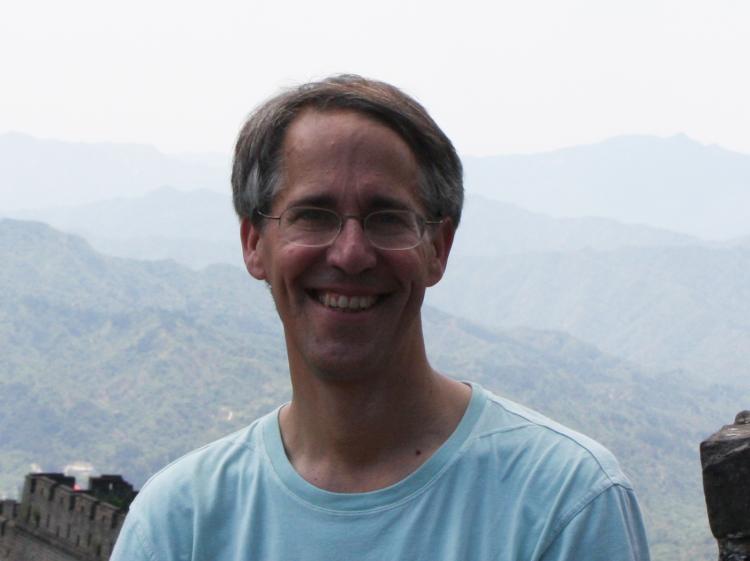Hong Kong rages against the dying light, expert says
Historian to speak at CU Boulder Oct. 23 on protests against growing control by China
Though most Americans have become aware of the struggle in Hong Kong only in the past few months, the people of Hong Kong have been protesting increasing control from China for many years.
But China expert Jeffrey Wasserstrom fears that the mass protests in the 426-square-mile “Special Administrative Region of the People’s Republic of China,” home to a cosmopolitan population of some 7.4 million, may be doomed, describing the struggle in poetic terms.

Jeffrey Wasserstrom. At the top of the page, protesters crowd a Hong Kong street this summer in protest of a controversial extradition bill. iStockphoto.
“Rage, rage against the dying of the light,” says Wasserstrom, Chancellor’s Professor of History at the University of California, Irvine, quoting Dylan Thomas’ famous poem about the inevitably futile human struggle with death, “Do Not Go Gentle Into that Good Night.”
“It’s a very dark moment.”
Wasserstrom will give a talk based on his upcoming book, Vigil: Hong Kong on the Brink (Columbia Global Reports, $15.99, due in February 2020), at 5 p.m. Wednesday, Oct. 23, in Room 270 of the Hale Science Building on the University of Colorado Boulder campus. The talk is presented by the Center for Asian Studies, the International Affairs Program and the Department of History.
Wasserstrom, whose PhD dissertation explored student protest movements on the Chinese mainland, has been visiting Hong Kong for decades. He was there in 2014 when the current wave of protest began and most recently visited in June.
Hong Kong Island became a British colony in 1842 at the end of the First Opium War. The colony was later extended to the Kowloon Peninsula in 1860 and in 1898 Britain was granted a 99-year lease on additional land.
In 1997, after much negotiation, the British turned Hong Kong over to the People’s Republic of China, with the stipulation that it would be allowed to “go its own way” for the next 50 years. To the surprise of some observers, the Chinese government largely abided by the agreement—at first.
“One reason (the Chinese government) let Hong Kong be as much as it did is that they wanted it to remain an attractive hub for international business,” Wasserstrom says.
Thus, the territory remained much more open than cities and provinces on the mainland. Newspapers were able to criticize the government and publish editorial cartoons mocking Chinese leaders. There was a tradition of vigorous protest. Citizens and visitors could buy a book praising the Dalai Lama, exiled spiritual leader of Tibet, a figure reviled as an enemy of the people on the mainland.
The protests are a last-ditch effort to defend the greater degree of freedom that Hong Kong has enjoyed.”
But during recent years, the Chinese government has begun systematically whittling away at Hong Kong’s more freewheeling culture and governance.
“A lot of aspects of Hong Kong life have been dying,” Wasserstrom says. “The protests are a last-ditch effort to defend the greater degree of freedom that Hong Kong has enjoyed.”
Drawing on work by Hong Kong writer Canny Leung, Wasserstrom likens the Chinese government’s efforts to the classic image of a frog in a pot of water that is slowly being brought to a boil. But now, the government has become bolder in its attempts to change Hong Kong, spurring mass protests.
First, there were 2012 protests responding to government efforts to shift civic and history education in Hong Kong from a more critical approach to the more patriotic, rigid curriculum used on the mainland. Then, a 2014 movement calling for more democracy and this year’s protests catalyzed by a move to allow the local government to extradite fugitives to the mainland.
Protesters are mostly young, college, high-school and even middle-school students, Wasserstrom says, but other demographic groups, from mothers to self-proclaimed “gray-hairs,” have also taken part. Some young protesters have taken heart from the “Hunger Games,” a series of dystopian young-adult novels by Suzanne Collins that spawned four hit movies.
“The characters (in the books and movies) are struggling against overwhelming odds. It’s David vs. Goliath, and—spoiler alert—it ends happily,” he says.
Wasserstrom says many Westerners assume, having seen American or British flags waving at demonstrations, that protesters identify with the West. In fact, he says, many see themselves as having been subject to two successive types of colonization.
“They see the current situation as one in which rather than Hong Kong entering a post-colonial period free of British control, they’ve simply gone from being the colony of one distant capital to being the colony of a closer, but still distant, capital, Beijing,” he says.
Now, Wasserstrom fears that politics in the United States and Europe have further emboldened the Chinese government in Hong Kong.
“In many ways, Donald Trump has been a godsend for the Chinese Communist party leadership,” he says. “He’s sent exactly the wrong kind of signal to a series of leaders, where he criticizes the country, but praises the strongman himself.”
Wasserstrom notes that many historical protest movements have taken years or decades before prevailing, such as the Solidarity movement in 1980s Poland.
“There were decades between the start of (Mohandas K.) Gandhi’s struggle in India to the end of the British empire,” he says. “The easiest way to see that (in Hong Kong) would be if Beijing itself went through a liberalizing phase. Unfortunately, there are no signs of that at the moment.”

